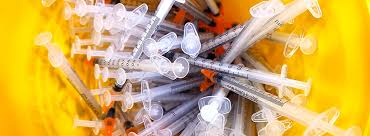Needle Waste Management: Challenges and Solutions

Strong 8k brings an ultra-HD IPTV experience to your living room and your pocket.
Needle waste disposal is a critical aspect of healthcare waste management, posing unique challenges due to its potential health and environmental risks. Sharps, including needles, syringes, and lancets, are essential medical tools used globally for administering medications, drawing blood, and delivering vaccines. However, improper disposal of these sharp objects can lead to injuries, infections, and environmental pollution. In this article, we will explore the challenges associated with needle waste management and discuss innovative solutions to address this pressing issue.
Challenges in Needle Waste Management:
Safety Risks:
One of the primary challenges in needle waste management is ensuring the safety of healthcare workers, waste management personnel, and the general public. Sharps injuries can result in the transmission of bloodborne pathogens such as HIV, hepatitis B, and hepatitis C. Improperly disposed of needles can pose a significant risk of accidental needlestick injuries, particularly in healthcare settings where large quantities of sharps are used daily.
Environmental Pollution:
Improper disposal of needles contributes to environmental pollution, posing hazards to wildlife, ecosystems, and communities. Discarded needles can contaminate soil, water bodies, and public spaces, endangering both human health and the environment. The presence of sharp objects in waste streams also complicates recycling processes and increases the likelihood of injuries to waste management workers.
Legal and Regulatory Compliance:
Compliance with regulations governing the disposal of medical waste, including needles, is another challenge faced by healthcare facilities and waste management organizations. Laws and regulations vary by jurisdiction and often require healthcare facilities to implement specific protocols for the safe handling, storage, transportation, and disposal of sharps. Failure to comply with these regulations can result in fines, legal penalties, and reputational damage.
Cost and Resource Constraints:
Proper needle waste disposal incurs costs associated with waste collection, transportation, treatment, and disposal. Healthcare facilities must allocate financial resources to procure and maintain sharps containers, train staff on safe disposal practices, and contract with licensed waste management companies. Limited financial resources may pose challenges for healthcare facilities, particularly in resource-constrained settings where funding for waste management infrastructure may be inadequate.
Public Awareness and Education:
Lack of public awareness and education about the proper disposal of needles is a significant challenge in needle waste management. Many individuals, including patients who use sharps at home, may not be aware of the potential risks associated with improper disposal or the correct disposal methods. Educating the public about the importance of safe needle disposal and providing accessible disposal options are essential steps in mitigating these risks.
Solutions for Needle Waste Management:
Safe Disposal Practices:
Implementing safe disposal practices is crucial for minimizing the risks associated with needle waste. Healthcare facilities should provide staff with training on proper sharps disposal techniques, including the use of puncture-resistant containers, segregation of sharps from other waste streams, and adherence to disposal regulations. Clear signage and instructions should be displayed to guide staff and patients on the correct disposal procedures.
Needle Take-Back Programs:
Needle take-back programs, also known as needle exchange or disposal programs, provide a safe and convenient way for individuals to dispose of used needles and syringes. These programs may be operated by healthcare facilities, pharmacies, local governments, or community organizations. By offering designated drop-off locations or collection events, needle take-back programs encourage proper disposal while reducing the risk of needle pollution in the community.
Needle Destruction Technologies:
Advanced needle destruction technologies offer efficient and environmentally friendly solutions for disposing of sharps waste. Autoclaving, microwave sterilization, and needle-melting devices can render needles and other sharps materials non-hazardous, allowing for safe disposal in regular waste streams. These technologies help mitigate the environmental impact of needle waste while ensuring compliance with regulatory requirements.
Encouraging Needle Safety Devices:
The use of needle safety devices, such as retractable needles and needleless injection systems, can help prevent needlestick injuries and reduce the volume of sharps waste generated. Healthcare facilities should prioritize the adoption of safety-engineered devices to protect healthcare workers and minimize the risks associated with needle handling. Incentivizing the use of needle safety devices through regulatory requirements or purchasing incentives can drive broader adoption across healthcare settings.
Public Awareness Campaigns:
Public awareness campaigns play a vital role in promoting safe needle disposal practices and raising awareness about the risks of improper disposal. Healthcare organizations, government agencies, and community groups can collaborate to develop educational materials, outreach programs, and social media campaigns to inform the public about the importance of proper needle waste management. These efforts should emphasize the significance of protecting public health and the environment through responsible disposal practices.
Needle waste management presents complex challenges due to safety risks, environmental concerns, regulatory requirements, and resource constraints. However, by implementing innovative solutions such as safe disposal practices, needle take-back programs, advanced destruction technologies, and needle safety devices, we can mitigate these challenges and promote a safer, healthier environment for all. Public awareness and education are key components of effective needle waste management, empowering individuals to make informed decisions and contribute to the prevention of needle pollution. Together, through collective action and collaboration, we can address the challenges of needle waste disposal and create a more sustainable future.
Note: IndiBlogHub features both user-submitted and editorial content. We do not verify third-party contributions. Read our Disclaimer and Privacy Policyfor details.


